Horticulture
Over the past hundred years the image of serried ranks of headstones in highly manicured and ordered grounds has grown to symbolise CWGC cemeteries. From the outset, the IWGC concept was more of garden cemeteries where equal thought and design was given to horticultural elements as to the ‘built’ elements.

The Gertrude Jekyll inspired ‘cottage garden’ was a strong influence on our planting style creating gardens in which the headstones sat, providing a quiet, contemplative space for remembrance with the horticulture softening the structures.
Staring into the climate crystal ball
Looking to the next hundred years and beyond, we are facing accelerating challenges and are constantly striving to innovate and develop while ensuring the cemeteries reflect their rich history and continue to be special places to visit.

Working at the beautiful CWGC Yokohama War Cemetery, Japan.
We are adopting a Right Ecosystem/Right Plant/Right Place approach to meet the climate of the future, transitioning to more sustainable landscapes and gardens which are in tune with the changing weather and climate but still have a strong sense of place and are easily identifiable as being ‘Commission sites’.

Tending the borders at CWGC Kuala Lumpur (Cheras Road) Civil Cemetery.
Our aim is to adopt a more holistic approach to managing our horticulture, thinking about design and layout in keeping with the surrounding landscape. For instance, in the Mediterranean where we have extensively used irrigation, selecting plants and species naturally suited to the location with the planting and management of the sites evolving as time goes by.

The compost farm at CWGC Thiepval, The Somme, France.
A key component of this approach is ensuring that the soil is as naturally healthy as possible to sustain healthy and vigorous growth. Where possible we select those plants which are naturally more disease and pest resistant and have ceased to use any fungicides or insecticides in our headstone borders. This enables natural predators such as ladybird larvae to keep aphids and other pests in check and provides a safe food source for a host of pollinating insects.

Overall, we have drastically reduced the use of environmentally damaging chemicals.
Inevitably climate change and erratic weather events will affect our horticulture. Using our own data and by collaborating with our network of horticultural organisations such as the Royal Horticultural Society and the Royal Botanic Gardens, Kew we can review research and data on how plants are performing both in the UK and around the world to give us a better understanding of the future challenges and how new plant choices, maintenance practices and resources can support the long-term sustainability of the horticulture in our sites.

Laying turf during the renovation of CWGC Kranji War Cemetery, Singapore
Around 250 of our sites across 54 countries currently use irrigation to sustain the style and layout of the horticulture, so efficient and effective use of limited or expensive water supplies is essential. Many of our constructed sites feature large areas of ornamental lawns potentially creating a heavy and unsustainable water demand in the long term. Provision of enough water of the right quality is a significant challenge, and we are actively working to build resilience and water efficiency into our sites.

An example of border planting at CWGC Halfaya Sollum War Cemetery, Egypt.
We are introducing the most up to date water saving technologies and progressively looking for opportunities to modify the landscape to reduce the water supply demand, e.g. by reducing the area of intensive lawns. This is underpinned by the need to ensure that our sites still inspire and delight.

Tree displacement at CWGC Catania War Cemetery, Sicily.
Some of our trees were planted 100 years ago and many are now coming to the latter stage of their viability across our estate. Succession planning to sustain our global green canopy is an important and growing challenge and like-for-like replacement of many species is becoming less of an option due to the impact of changing climate. In selecting suitable replacements, we need to consider climate projections 30 -50 years in advance to determine the best species to ensure resilience and longevity at our sites and we are accessing the best scientific data through Botanic Gardens and Conservation International to inform our decision making.

Tree planting at CWGC Mory Abbey Military Cemetery, Mory, Pas de Calais, France.
Maintaining our worldwide horticultural estate requires a wide range of machinery, equipment and tools. Where the technology exists, and if feasible, we are phasing out machines that use fossil fuels for battery powered alternatives and where opportunities exist, we are working with our suppliers to help develop battery powered versions of the specialist machines we need.

Training session at CWGC Christiansborg War Cemetery, Ghana.
Our global estate requires knowledgeable, trained, and motivated horticulturists. As much of our workforce is nearing retirement age there is a growing demand for new gardeners in our global team. To support them, their career aspirations and continued professional development we are investing in new training materials, training initiatives and programmes, apprenticeships and opportunities to be the best they can be within the broad range of technical roles.
To the Four Corners...
Read about some of the many challenges our horticultural teams face around the world.
Keep your ear to the ground

Beirut WAR CEMETERY
Location: Beirut, Lebanon Language: Arabic Altitude: 33m
Temperature: 10°c - 31°c Biggest challenge: Security / weather
Before going to work, the Commonwealth War Grave Commission’s Lebanese gardeners always switch on the local radio. Though the dry summers and spring flash floods cause them enough problems, they’re not listening to check the weather – they’re making sure it’s safe to go to work.
It’s a necessary precaution. Beirut has found itself the centre of attention for dangerous reasons in the past. There’s still political instability in neighbouring countries. A refugee centre near CWGC’s Beirut War Cemetery can at times be the focal point for tense stand-offs that spill out into the street.
Gardeners are on strict instructions to stay home at the slightest sign of trouble.
Thankfully, most days in Beirut begin peacefully enough. An early start before the sun’s punishing summer heat is normal for head gardener Yousef.

Archive image of Beirut War Cemetery after the First World War before the city grew around it.

The entrance to Beirut War Cemetery decorated with flags on Armistice Day in 1924.
Beirut War Cemetery’s grand date palms can only provide so much shade and the locally grown roses need constant attention to stay in bloom.
The war cemetery here is split into two parts: The First World War section is dominated by the graves of men who died of Spanish flu during the military occupation in 1918-19.
On the other side of the road, the Second World War part pays testament to the cost of the brutal fighting to reclaim the city from Vichy French and subsequent occupation.
And the World Wars weren’t the last time shots were fired here. During the complex Lebanese Civil War, it’s said the cemetery was used as an artillery position.
Throughout the 70s and 80s, the local gardeners did what they could despite repeated calls by the Commission not to put themselves at risk.

1982 photo showing the damage caused during the Lebanese Civil War.

On top of graffiti and vandalism, nearly 1,000 headstones were destroyed during the Lebanese Civil War.
One close call saw the head gardener forced to take cover behind a wall for an hour while sheltering from a bombardment.
By the time the civil war ended the number of headstones damaged by missiles and shell fire nearly reached 1,000. Luckily the damage was only superficial. The graves remained undisturbed and by 1994 the cemeteries were completely restored by the Commission.
Today, it’s the weather that causes the most problems. Flash spring floods and long, hot summers mean tending to flowers is a constant war against the elements, making that weather forecast on the radio important to pay attention to as well.

Despite the trying weather conditions, CWGC's local team manage to make these Europeana roses flourish.
An Oasis of calm

Gaza WAR CEMETERY
Location: Gaza City Language: Arabic Altitude: 39m Rainfall: 148mm
Temperature: 9°c - 36°c Biggest challenge: Missile strikes and power cuts
Despite missile strikes, power cuts and make do and mend machinery – CWGC’s war cemeteries in the Gaza Strip remain carefully tended oases of calm.
The region’s instability spills onto the global news on a weekly basis, impacting the daily lives of those who live and work there. But the Commission isn’t in the game of politics. We’re gardeners and guardians of heritage.
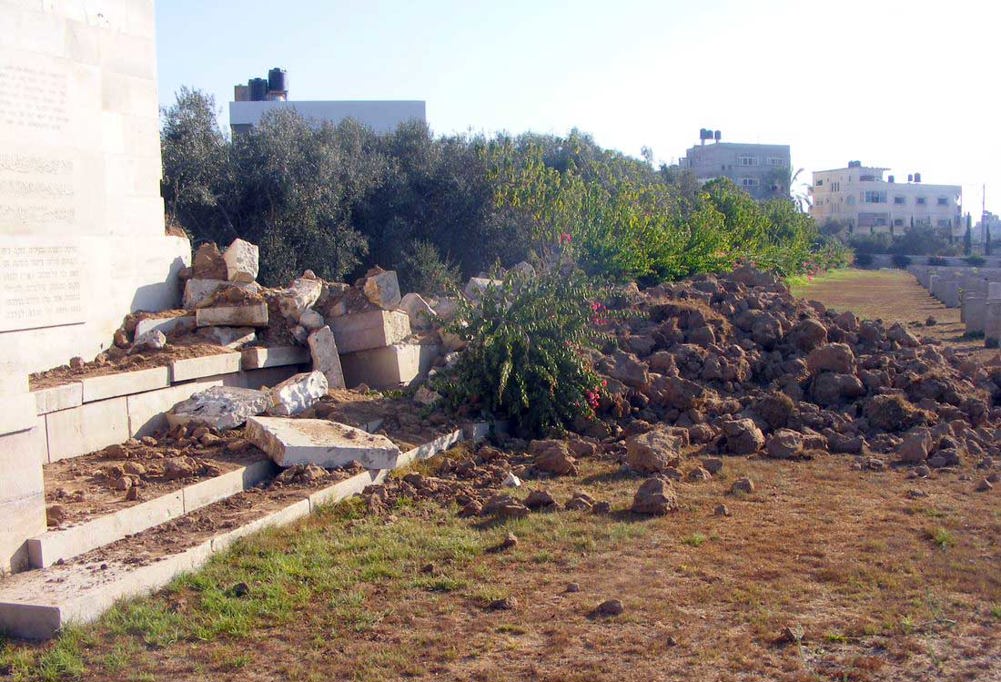

Many times in the history of Gaza War Cemetery, the site has been caught in the crossfire.
When chaos reigns outside the walls of our cemeteries here, the local team does as much as they can to maintain a sense of calm and normality within.
The setbacks they face are significant. Sometimes our sites get caught in the crossfire. Gaza War Cemetery has been hit three times in the last decade alone; on one occasion nearly 300 headstones were damaged.
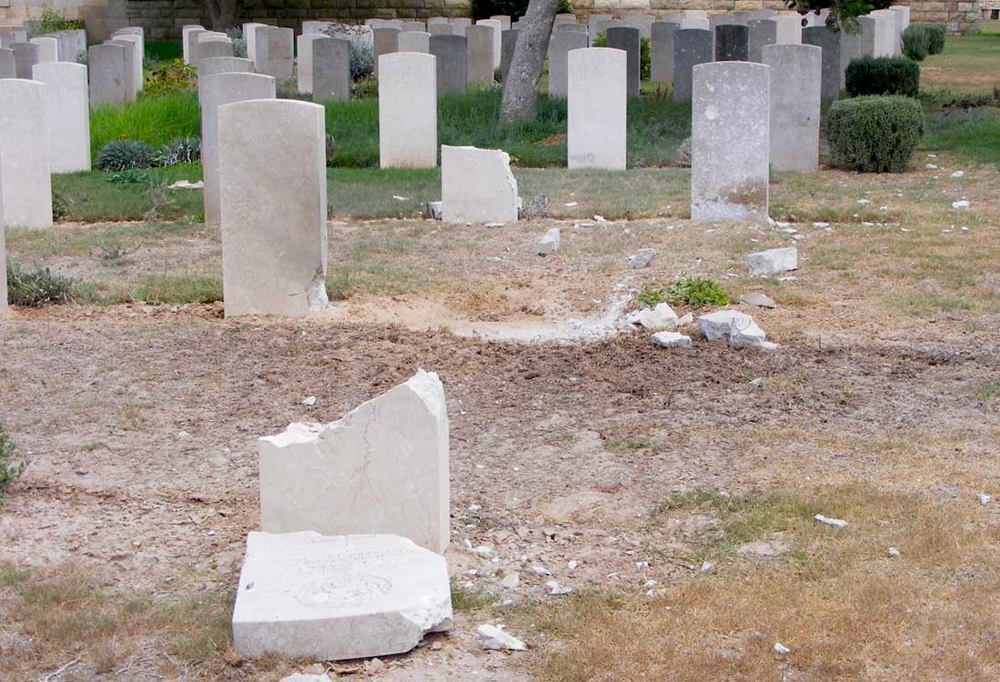
On one occasion, nearly 300 headstones were destroyed by a stray missile.
A former gardener used to talk of once chasing armed militants away with his broom. Today, we insist staff look after themselves first. But even when things are calmer they face continual issues.
The Gaza Strip suffers from major water and electricity shortages – a big problem when your job is maintaining a garden cemetery. The last time petrol ran out, staff modified machinery to run on gas.
Just getting equipment through the tight border controls can be a problem. Something as simple as a replacement lawnmower can take months, sometimes years, to arrive.

Once it's safe to return, staff are quick to clean up and begin repairs.
In spite of all of this, our dedicated and resourceful team continue to do the Commission proud. On top of the impressive standards, the war cemeteries are used as a teaching spaces too.
In an area where conflict and loss are all too fresh in people’s minds, team member Ibrahim Jaradah – the fourth generation of his family to work for us – guides groups of local children, reminding them that every life lost, no matter the cause, is something that should be remembered.
He said: “Our responsibility is not easy. Our task is to preserve these cemeteries against many challenges. We feel the weight of expectations, but we also feel the importance of our work.”


Despite the difficulties our team in Gaza have created a real oasis of calm.
The country with two climates

Keren WAR CEMETERY
Location: Keren, Eritrea Language: Tigrinya, Tigre, Arabic Altitude: 1403m Rainfall: 411mm
Temperature: 18°c - 40°c Biggest challenge: Weather
For those unfamiliar with World War history or African geography, you could be forgiven for not being able to point to Eritrea on a map.
It sits on the Horn of Africa, north of Somalia, and was once the scene of fierce fighting in the Second World War. Men from around the world – Britain, Undivided India, South Africa and Sudan – assembled in a narrow mountain pass here in 1941.
The Battle of Keren was key to the Allies’ fight against the Italian occupiers in Eritrea. Tens of thousands of men from both sides fought across a steep gorge and mountain pass for control of the roads towards the city, and ultimately the route to the capital Asmara.

Keren War Cemetery was one of the very first new cemeteries built after the Second World War.
On the outskirts of the city stands the Commonwealth War Graves Commission’s (CWGC) Keren War Cemetery. One of the first to be built after the Second World War, it is almost entirely unaltered since it was constructed.
It stands as a permanent reminder of more than 700 Commonwealth men who died here. The tough conditions make it a little more challenging for CWGC’s local team to maintain the dotted horticulture that can survive the arid climate.
Despite the challenges, it remains a beautiful setting for the few visitors who can negotiate the visa process and stand here, in the peaceful shadow of the mountain ridges that so many men died fighting for control of.
Alongside rows of headstones is the Keren Cremation Memorial, a common feature where the Indian forces fought. Men who were cremated in accordance with their faith are remembered here by name.

Despite the hot, dry weather, dotted horticulture is still possible in Keren.
Among them is Richhpal Ram VC who was posthumously awarded the highest military honour for his bravery during the battle.
“Just two hours away from Keren you find our other war cemetery in Eritrea,” said Rich Hills, CWGC’s regional director.
“In the country’s capital Asmara the environment is distinctly different. While Keren is arid and dry, in Asmara the air appears to have more moisture, the surrounding terrain is very wooded and green and there’s a large cactus forest behind the cemetery.”

The damper climate in Asmara makes it possible for vibrant plant life to survive.
Although water must always be managed carefully in Asmara, the difference in microclimate is very noticeable and our horticulture faces less of an uphill battle.
While the work of our dedicated team in Eritrea is varied and far from common knowledge, it’s also far from finished.
We constantly look forward to ways in which we can increase the standards of maintenance at these remarkable sites.

The stark difference between Asmara (pictured) and Keren is seen in the different planting schemes.

Two of our long-term dedicated teams in Eritrea next to Asmara War Cemetery's Cross of Sacrifice.
The danger of wild boar

Kranji WAR CEMETERY
Location: Singapore Language: English, Malay, Mandarin Altitude: 23m Rainfall: 2,340mm
Temperature: 24°c - 33°c Biggest challenge: Wild boar, weather
Cracked headstones and torn-up turf, all courtesy of our least wanted guest in Singapore – wild boar.
The creatures prove a real problem for the Commonwealth War Graves Commission. The open land of Kranji War Cemetery, on the outskirts of the Asian city-state, is an appealing place for them.
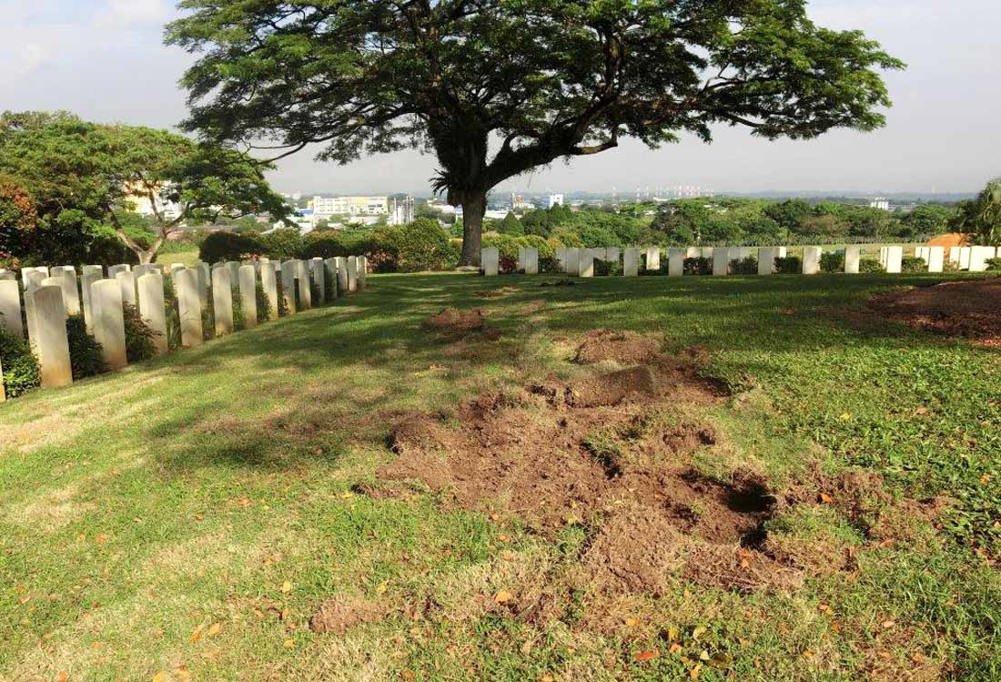
The tell-tale signs of wild boar damage. When a wild boar is spotted, our cemetery must be evacuated.
For decades gardeners here have had to look out for boar and the damage they cause to the war cemetery they care for. More than 4,000 Second World War dead are buried here. Another 25,000 are named on a series of war memorials.
From high up on this vantage point, you can look out and see where the Japanese Army came from on that fateful February of 1942, during the Battle of Singapore.
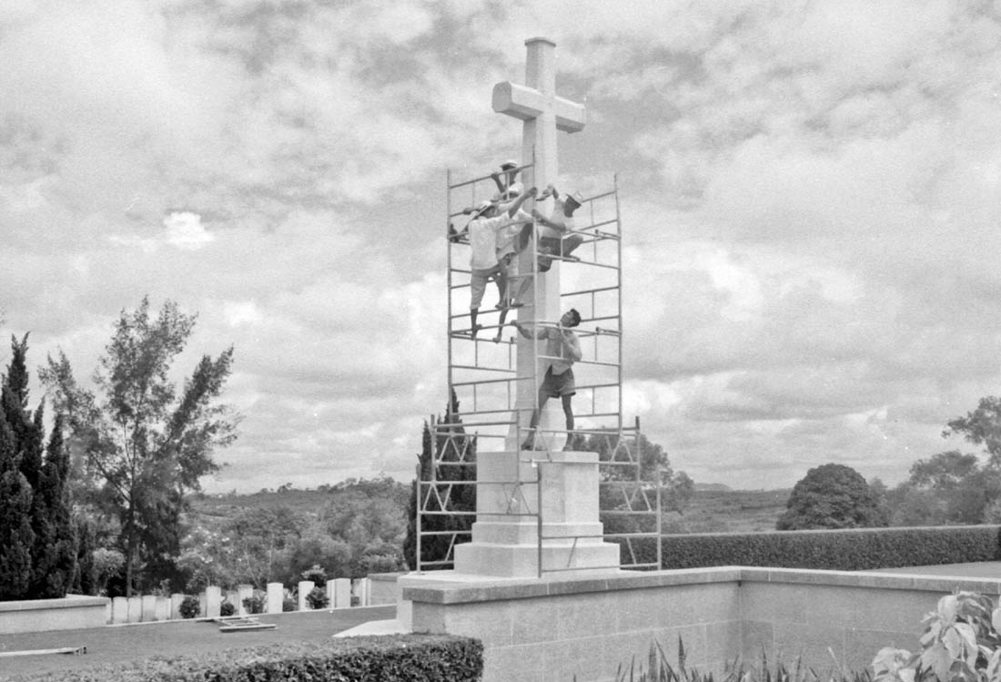
Kranji War Cemetery's Cross of Sacrifice under construction after the Second World War.
Christopher Leong, our head gardener at Kranji, is all too familiar with the challenges of preserving this reminder of all those lost lives.
His team take seriously any sighting of wild boar, immediately evacuating the site.
Specialist fencing runs deep underground to prevent all but the most determined of invaders from getting through.
It’s not just animals that put pressure on this historic site. The weather plays its own part too, bringing trees down in the monsoon.
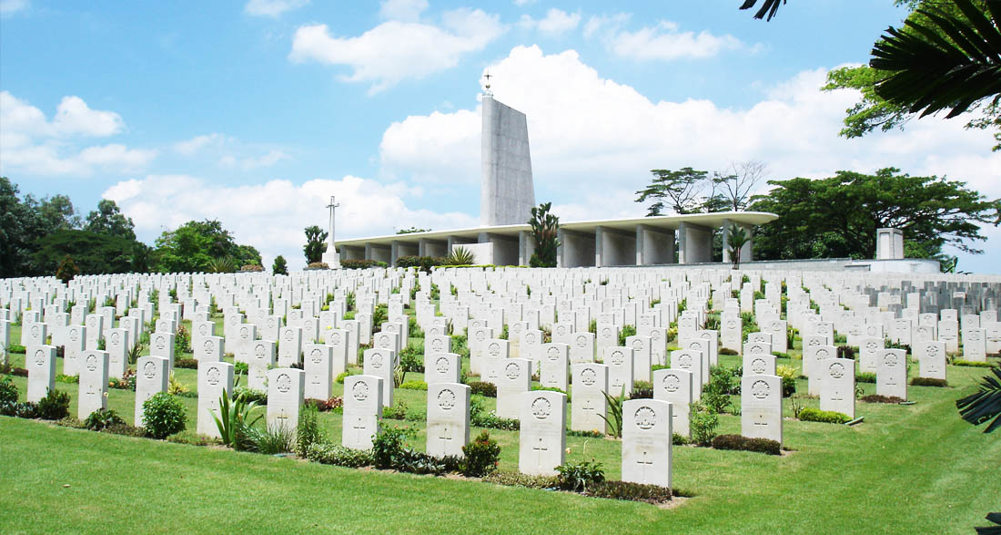
The grand Singapore Memorial, bearing more than 24,000 names, stands at the top of the cemetery.
The Singapore Memorial sits on the highest point of the hillside cemetery now. The iconic design pays tribute to the air force, navy and army – the wings of a plane, the fin of a submarine, and the rows of soldiers stood to attention.
Weathering has already taken its toll on the memorial. CWGC is restoring the structure, tearing off the old waterproof layer on its roof, and replacing it with more robust modern materials.
While the wild boar might be a dangerous visitor, the cemetery still draws in people wanting to pay their respects. Every year thousands turn out for the Remembrance Sunday service, just the kind of guests our founders had in mind, all those years ago.
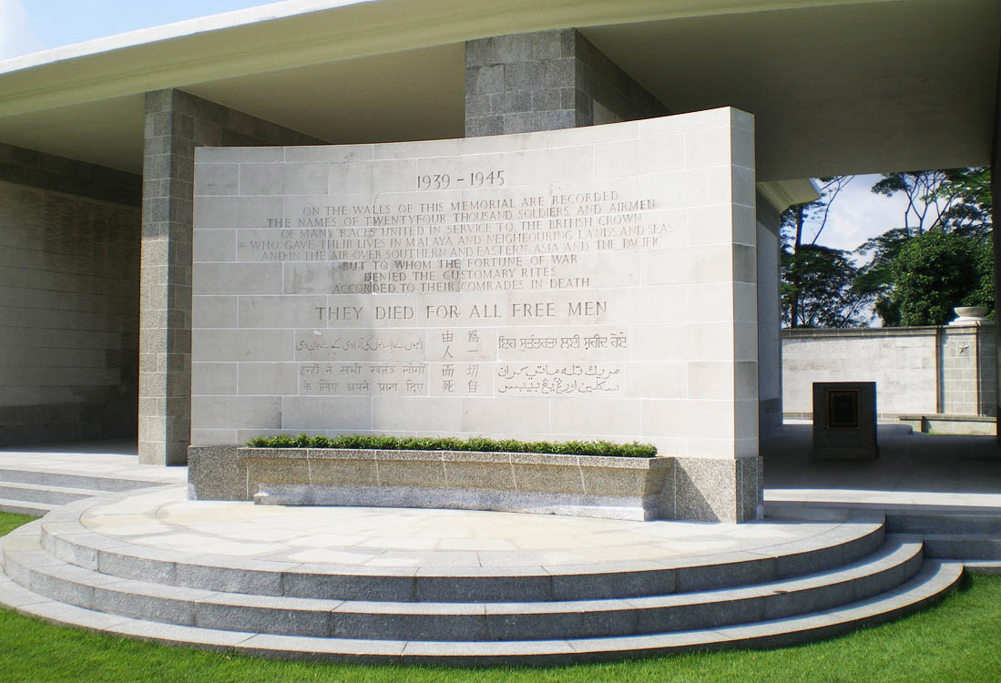
gardens of the death railway
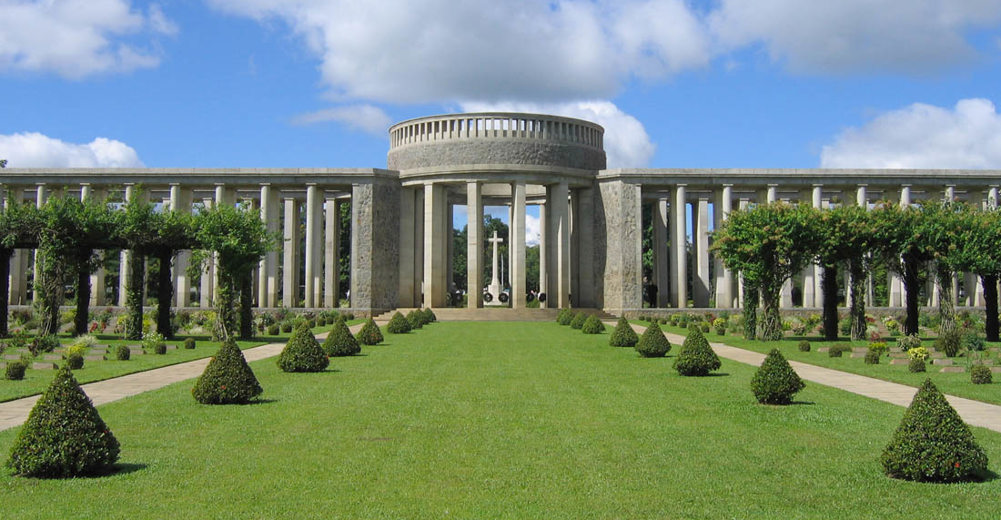
Thanbyuzayat WAR CEMETERY
Location: Thanbyuzayat, Myanmar Language: Burmese Altitude: 23m Rainfall: 2,378mm
Temperature: 19°c - 41°c Biggest challenge: Extreme weather
Pounding heat and flash floods – the weather in Myanmar poses the Commonwealth War Graves Commission its fair share of difficulties.
Our team here is responsible for maintaining nearly 12,000 graves, but the graves look a little different to those familiar with our work in Europe. Each one is marked by a bronze plaque set into the ground on a pedestal of stone.

In Myanmar bronze plaques take the place of Portland headstones to better withstand the climate.
These plaques weather better than Portland headstones in the intense heat and the rain of South East Asia.
In Yangon – known to the British during the Second World War as Rangoon – we face opposing problems from the weather.
Rangoon War Cemetery, in the busy city centre, gets regularly submerged by flash floods. Our gardeners have to sweep away debris on a daily basis in the rainy season.
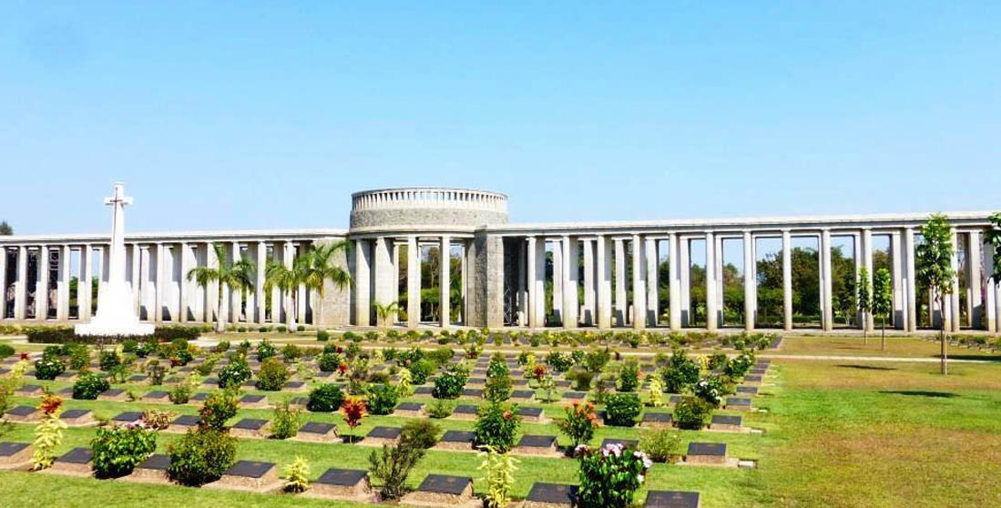
The iconic Rangoon Memorial at the heart of Taukkyan War Cemetery.
Yet just one hour away on the outskirts, at Taukkyan War Cemetery, we face a constant battle against the parched ground in the brutally hot and dry weather.
Taukkyan is a vast cemetery with almost 6,500 graves. They are carefully laid out in rows around the distinctive shape of the Rangoon Memorial, which lists almost 27,000 missing war dead.
The war memorial is beginning to show signs of its age and we are preparing to restore it.
In its shadow, lies a more recent row of bronze plaques. They sit in a special plot, naming the 16 men aboard Dakota KN584.
The plane crashed in September 1945 killing all aboard. Only recently was it found they had been buried deep in the jungle, making recovery impractical. Instead, their relatives now have somewhere accessible to pay their respects with a row of special memorials in our war cemetery.
The last of our three sites in Myanmar is Thanbyuzayat. The cemetery sits a stone’s throw from the end of the infamous death railway.
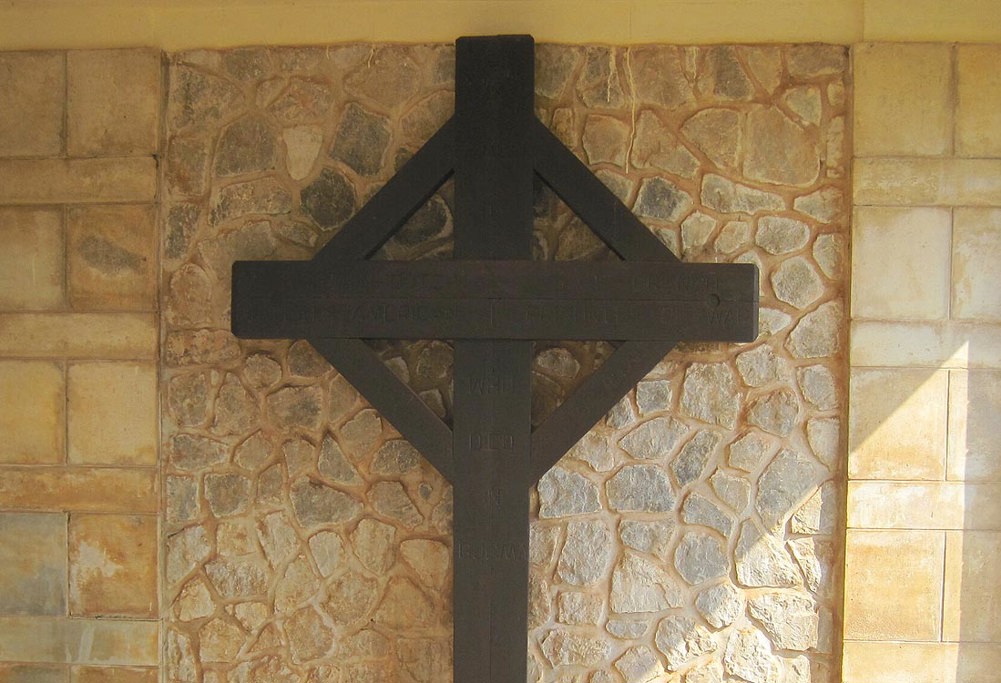
A cross at the entrance to Thanbyuzayat, made from wooden sleepers on the death railway.
This cross-country route was built by forced labour, including prisoners of war, during the Second World War, in often gruelling conditions. It has been said that a man died for every sleeper laid across the 415-kilometre (258 mi) route of the railway. Many of those who died, lie at rest in CWGC’s care.
And as a reminder of what they went through, visitors to Thanbyuzayat will see a handmade wooden cross in the cemetery’s entrance, assembled out of those infamous railway sleepers by prisoners.

Our dedicated team in Myanmar.
Gardening in the crosshairs
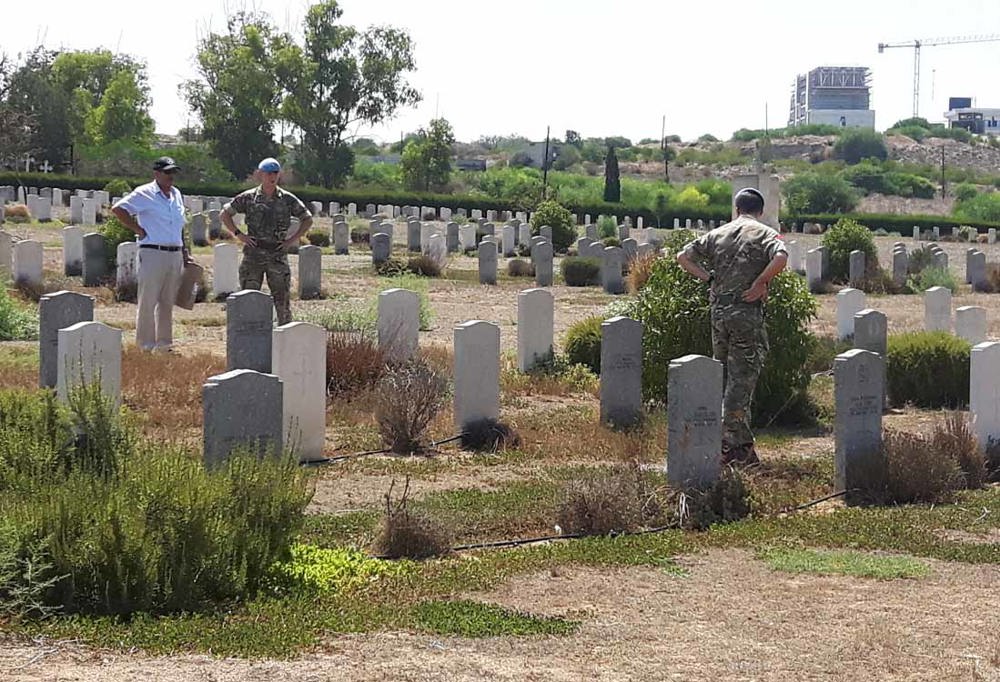
Wayne's Keep: Nicosia War Cemetery
Location: Nicosia, Cyprus Language: Greek, Turkish Altitude: 159m Rainfall: 324mm
Temperature: 9°c - 34°c Biggest challenge: Cemetery in buffer zone
Just getting to work is a real challenge for one of our Cyprus-based teams.
The war cemetery in question is less than an hour from our Mediterranean head office and sits just on the outskirts of the country’s capital.
The difficulty comes from the important invisible lines that surround Nicosia War Cemetery, or Wayne’s Keep as it’s often known.
Since the 1970s the disputed border between the southern and northern parts of the island has run right across the cemetery.
One side believes it sits in the buffer zone, and the other, that it sits firmly inside their territory.

A UN escort is needed for any CWGC staff or contractors to enter Wayne's Keep.
In places, the buffer zone is so untouched by human influence that species thought long extinct have been spotted.
Throughout half a century of land disputes, the Commission’s commitment has been difficult but not impossible to fulfil. Within this sliver of no man’s land, we are tasked with maintaining the graves of more than 200 Second World War dead and a series of memorials.
Next to them are close to 600 British military dead, servicemen stationed on the island after the War when it was still part of the British Empire or as part of the United Nations task force deployed to enforce the uneasy peace between north and south. CWGC continues to take responsibility for their graves on behalf of the MOD.
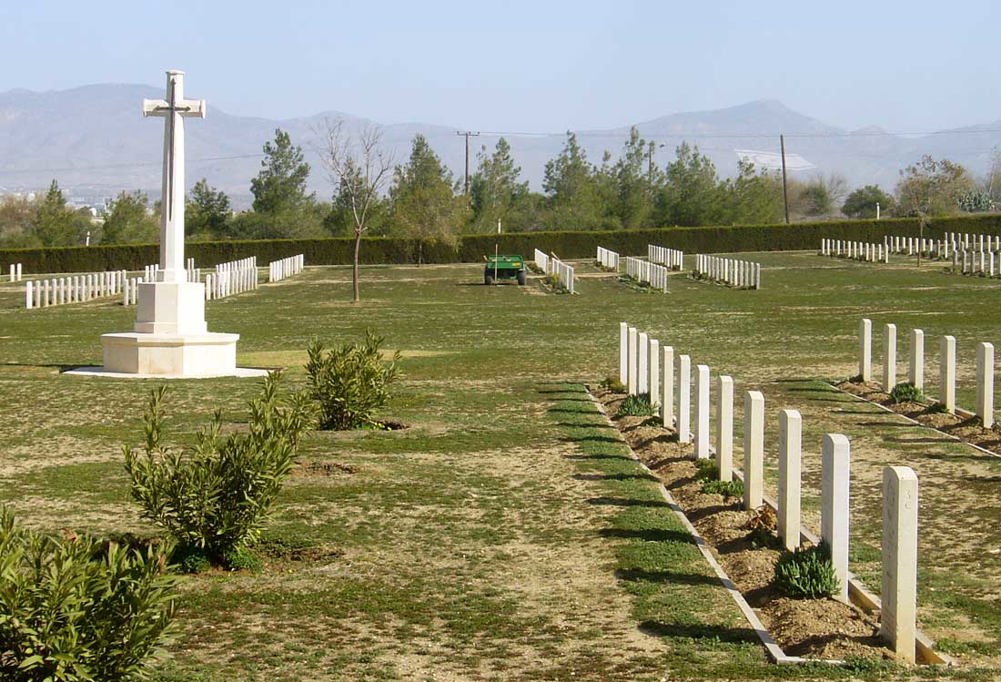

When access is restricted the horticulture on site begins to suffer.
To undertake even the most minor of work to the various sections of this cemetery, staff and contractors must gain special permission and be accompanied by a UN escort. Armed guards on the northern side are always present.
Surely there are few other gardeners in the world who mow the lawn under such watchful eyes.
As tensions rise and fall CWGC’s work continues to get caught in the mix. On more than one occasion people have been asked to leave the site by armed guards. For those living on the island, the presence of the border and the buffer zone is a part of daily life. We are in no position to challenge or question the wider situation.
Instead, we must continue to work peacefully with all involved to ensure those buried in the crosshairs of today’s dispute are not forgotten.
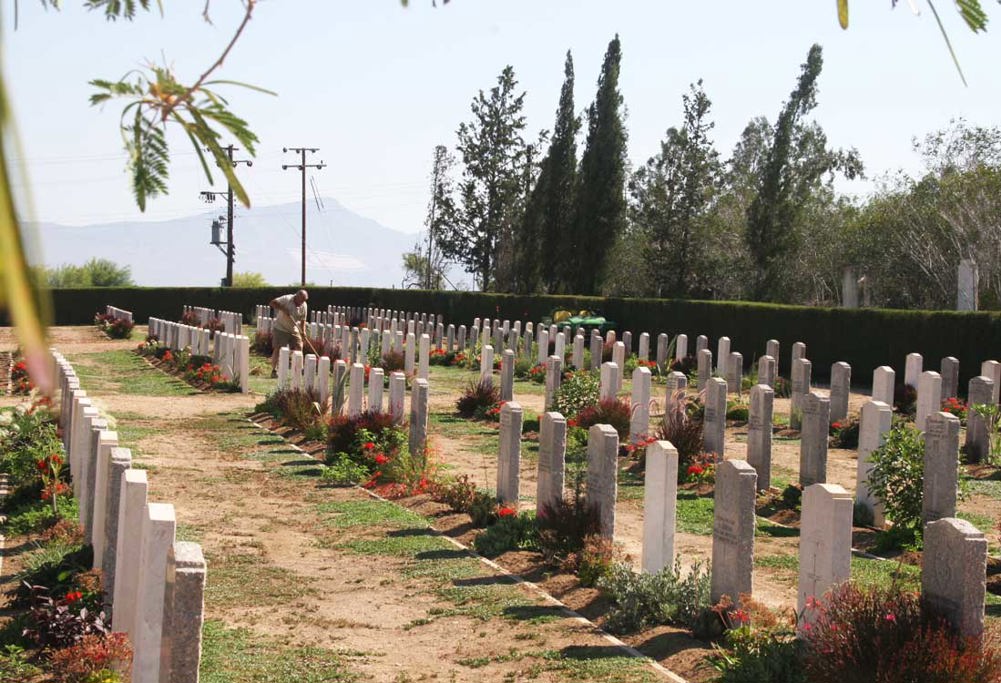
Borders full of colour are currently not possible to maintain due to limited access within the buffer zone.
Recovering from the storm

Yokohama WAR CEMETERY
Location: Yokohama, Japan Language: Japanese Altitude: 73m Rainfall: 1,530mm
Temperature: -3°c - 31°c Biggest challenge: Typhoons
A few hours after the storm passed Kengo and his team set to work. The strong winds had ripped up trees and impaled them on the cemetery’s neat lawn. Elsewhere in Japan, the outcome was even worse.
Yokohama, a neighbouring city of Tokyo, like much of the region, suffered from the effects of the deadly Typhoon Hagibis in October 2019.
As well as the serious loss of life, power and property, the Commonwealth War Graves Commission’s only war cemetery in Japan fell victim too.

Winds up to 160mph ripped apart trees in Yokohama during Typhoon Hagibis.
Thankfully all staff and their families were unharmed. Only hours before it struck, Kengo Kobayashi, CWGC’s Japan country manager, was in the cemetery, giving a video tour and discussing which trees might be at risk.
The next day his team set to work quickly clearing up the aftermath.
In calmer times this space boasts an abundance of life; flowers and trees that mix native Asian species with more regional varieties that reflect the Commonwealth war dead buried below.
Created after the Second World War, Yokohama contains the remains and war memorials of more than 2,000 war dead.

Yokohama is divided into five sections for the Commonwealth and post-war.

The ashes of 335 men from the Commonwealth, USA and the Netherlands sit inside the Yokohama shrine.
Most were Prisoners of War who died in captivity in gruelling conditions. Their lives and deaths are now preserved in this parkland setting amid the largest urban area on the planet.
Nearby, hundreds of thousands of rugby fans have poured through the doors of the Yokohama International Stadium during the Rugby World Cup; many Brits, Australians and New Zealanders among them.
While their thoughts will have been on tries and tackles, our Japanese staff were watering and weeding the Commonwealth graves of those fans’ forebears – men who only a few generations ago would have been enemies.
And among those graves, there is buried a true friend. In the non-war plot lies former Commission gardener, Len Harrop MBE. Ex-soldier and guardian of this cemetery from 1952 to 1986.
From the harrowing work of recovering bodies to cultivating plants, his life spanned the battlefields of Normandy to Yokohama War Cemetery. And just as he did for more than three decades, when the storm winds passed, the latest generation of CWGC staff returned to make sure that everyone buried there could continue to rest in peace.

CWGC staff at work on a quieter day, tending our only Japanese war cemetery.

